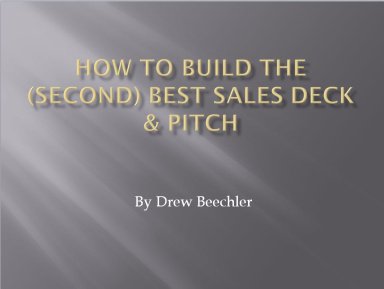
Last version published: 19/12/2017 13:33
Publication number: ELQ-19276-3
View all versions & Certificate

How to Build the (Second) Best Sales Deck and Pitch
A guide on how to deliver an engaging sales pitch, by using successful past sales pitches as a good reference model.
Introduction
Last September, Andy Raskin wrote an amazing post breaking down the Zuora sales deck as “The Greatest Sales Deck I’ve Ever Seen”. Last month, he followed up that article with another post entitled, “The Greatest Sales Pitch I’ve Seen All Year” where he broke down the Drift sales deck and pitch. After reading Andy’s article on Zuora last year, I started writing this article, but never ended up finishing it. After reading his latest post on Drift, I decided it was time to dust off this draft and finish it.
After reading both of Andy’s articles, I couldn’t help but see the similarities to how Salesforce has structured their sales decks and keynote presentations for the last 10+ years as well — I would argue it heavily influenced both Zuora and Drift’s approach considering Zuora’s CEO Tien Zuo was the 11th employee at Salesforce and their first CMO. Because of this, I wanted to follow Andy’s structure and dig into Salesforce’s “strategic narrative” in their famously effective sales pitch.
- Step n°1 |
The 5 Elements of Salesforce’s Strategic Narrative
I began my career in Content Marketing at ExactTarget, the leading digital marketing platform, which was purchased by Salesforce for $2.7B in 2013. I stayed with Salesforce through the acquisition and spent my last year at Salesforce working on their corporate marketing team focused on “cross-cloud” product marketing and positioning.
During that time, I got to see some of the magic behind Salesforce’s industry-leading product marketing and messaging. The narratives built in these positioning discussions became the basis for the Dreamforce keynote, which would eventually trickle down to every sales rep and sales deck across the company.
And Salesforce is the king of narratives and keynote presentations — from The Social Enterprise and the Salesforce1 Platform to the Customer Success Platform and their current “Blaze Your Trail” messaging. With Dreamforce this week, I thought it only fitting to write a follow-up to Andy’s posts showcasing the same five elements of a brilliant product marketing and sales narrative from Salesforce. - Step n°2 |
#1. Industry Transformation
Andy asserts, “Name the undeniable shift in the world that creates both (a) big stakes and (b) huge urgency for your prospect.”
After kicking off all presentations with their infamous Safe Harbor statement and “Thank You” slide to all their customers, partners, and employees, Salesforce dives directly into their “industry transformation” slide below.
This slide (see picture), now over 14 years old, is one of the most famous Salesforce slides ever made — and it’s still being used to this day. Salesforce opens every keynote and presentation with a version of this slide. You can always recognize this slide as it visually depicts the computing transformation that’s taken place over the last few decades.
Don’t focus on the problem from the beginning — frame your audience’s state of mind to understand the tectonic shifts happening in the industry that make what you are about to talk about a BIG deal. Salesforce shows that this shift is inescapable and needs to be addressed
add_shopping_cartContinue reading for free (70% left)

